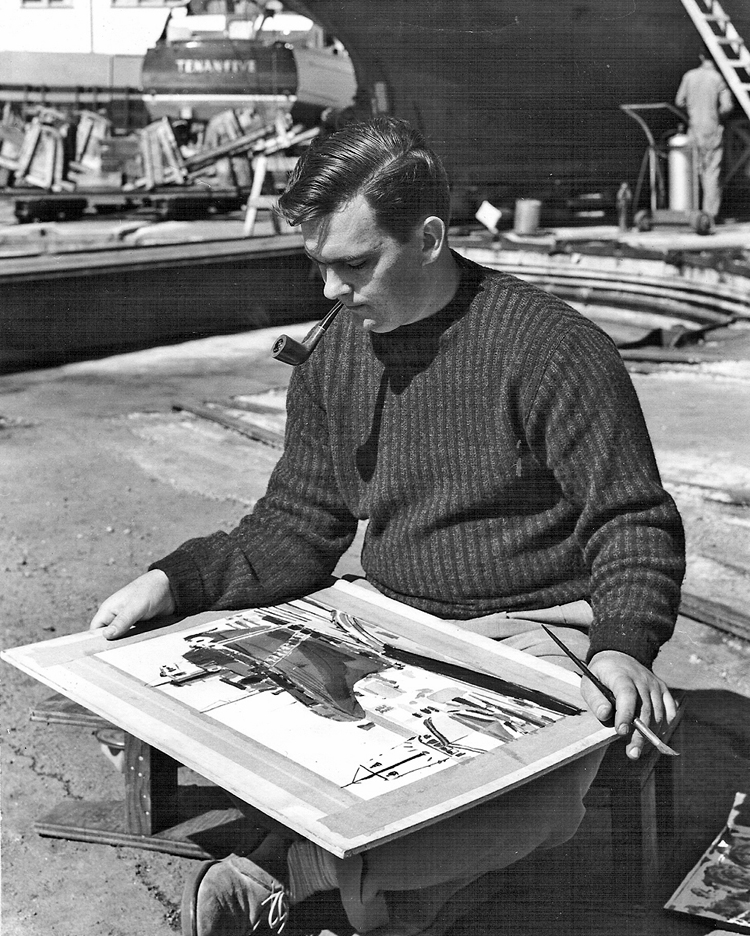
Eight Bells — Remembering Jim DeWitt
On November 19, 2022, Bay Area sailmaker, sailboat designer and artist extraordinaire Jim DeWitt passed away at home in Point Richmond under the care of hospice. He was 92 years old and had suffered a stroke a couple of weeks before.
James Harden DeWitt was born in Oakland on February 13, 1930. Jim became fascinated by sailboats and art at an early age. When he was 7, he drew pictures of sailboats while watching his dad build a 19-ft sloop in their backyard. He built his own first boat, El Toro #216, when he was 19. Jim graduated from Oakland High School, but he didn’t enjoy school — turns out he was dyslexic at a time when no one understood what that was. But he did well in his art class, and his mom got him into art school. He attended the California College of Arts and Crafts in Oakland, then the Los Angeles Art Center in Pasadena.

To save money while going to school, he started making his own dinghy racing sails, building the first, for his El Toro, in 1959. “I was my first customer,” he said.
Jim married his first wife, Dorothy May Swinson, in 1950. (They married and divorced twice!) In 1960, Jim returned to the Bay Area with his young family and opened DeWitt Sails in a Quonset hut in Richmond.
In 1980, he moved the business into a new building in Brickyard Cove, which included his art studio. In 1983, Jim sold the sail loft to Sobstad in order to focus on his art career. (Sobstad later sold to Quantum, which is still there in the same building.) Parallel to his professional careers was his yacht racing career. In 1961, he won the Bullship Race, in which El Toros sail across the Golden Gate from Sausalito to San Francisco. In 1963, he won the North American Men’s Championship in Annapolis, with the daringly mixed-gender crew of Jocelyn Nash and Jake van Heeckeren. Jim thus became the first West Coast skipper to bring home the Mallory Cup. From 1969 to 1977, Jim had a series of successes in the Lipton Cup. He won the 1992 International Masters Regatta, sailed in J/24s in San Francisco.
In the 1990s, Jim designed the roto-molded plastic DeWitt Dinghy. Fleets of the little yellow boats were ubiquitous at yacht clubs with junior programs. Some later models were made from fiberglass. “I never made any money off those,” he told us.
But Jim is best known in today’s sailing community for his paintings. His exuberant colors and bold shapes burst off the canvas. His subjects range from people to pets to flowers, but especially sailboats and yacht racing. His canvases adorn the walls of many a yacht club and other maritime enterprises. You can even spot his murals if you stroll around Point Richmond.
Continue reading in the January issue of Latitude 38.

What a wonderful man to have met. An amazing cornerstone of west coast sailing history! It was an honor to have him sponsor the Master Mariners last year. He was a true master Mariner!
I am so proud that Kaze was one of his painted fleet, almost the last one!
Jim will be missed as a man and his paintings were fantastic!
Sorry to hear of Jimmy’s passing the bar. I will continue to remember the used “Flower Pot” (Jimmy’s unsinkable 8 foot sailing dinghy) we named Frodo. I am fortunate to have one original DeWitt painting, and a print of another from the ’80s that captures the beauty of spinnakers and bloopers quickly driving IOR lead mines down wind in a blow. An artist of great caliber, who chose to show our sport in all its glory.